
The Parmeliaceae is a large and diverse family of Lecanoromycetes. With over 2700 species in 71 genera, it is the largest family of lichen-forming fungi. The most speciose genera in the family are the well-known groups: Xanthoparmelia, Usnea, Parmotrema, and Hypotrachyna.

The Lecanoraceae are a family of lichenized fungi in the order Lecanorales. Species of this family have a widespread distribution.

Masonhalea is a genus of two species of lichenized fungi in the family Parmeliaceae.
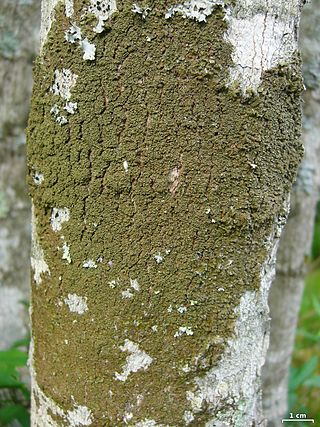
Melanohalea is a genus of foliose lichens in the family Parmeliaceae. It contains 30 mostly Northern Hemisphere species that grow on bark or on wood. The genus is characterized by the presence of pseudocyphellae, usually on warts or on the tips of isidia, a non-pored epicortex and a medulla containing depsidones or lacking secondary compounds. Melanohalea was circumscribed in 2004 as a segregate of the morphologically similar genus Melanelia.

Melanelixia is a genus of foliose lichens in the family Parmeliaceae. It contains 15 Northern Hemisphere species that grow on bark or on wood. The genus is characterized by a pored or fenestrate epicortex, and the production of lecanoric acid as the primary chemical constituent of the medulla. Melanelixia was circumscribed in 2004 as a segregate of the related genus Melanelia.
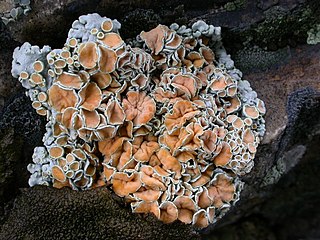
Rhizoplaca is a genus of lichenized fungi in the family Lecanoraceae. Members of the genus are commonly called rimmed navel lichens because of their umbilicate growth form and lecanorine apothecia, also rock-posy lichen and rockbright.

Protoparmeliopsis garovaglii is a species of saxicolous (rock-dwelling), crustose lichen in the family Lecanoraceae. The species was originally described as Placodium garovaglii by German lichenologist Gustav Wilhelm Körber in 1859. It was later classified in Lecanora in 1900, and known as a member of that genus for more than a century. Molecular phylogenetics showed that Lecanora was highly polyphyletic, and as a result, the genus was divided into several smaller, more phylogenetically natural genera. Subsequently, in 2015, Lecanora garovaglii was transferred to genus Protoparmeliopsis.
Rhizoplaca shushanii is a species of crustose lichen in the family Lecanoraceae.
Rhizoplaca porteri is a species of crustose lichen in the family Lecanoraceae.
Rhizoplaca polymorpha is a species of crustose lichen in the family Lecanoraceae.
Rhizoplaca parilis is a species of crustose lichen in the family Lecanoraceae.
Rhizoplaca occulta is a species of crustose lichen in the family Lecanoraceae.
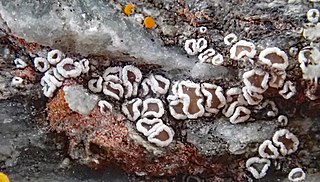
Myriolecis is a genus of lichen in the family Lecanoraceae. It was originally circumscribed in 1909 by Frederic E. Clements with Myriolecis sambuci as the type species. The genus was later reinstated to accommodate the Lecanora disperse group and Arctopeltis. Molecular phylogenetic data showed that this group of species formed a clade that is genetically distinct from Lecanora, and Myriolecis was the oldest name available to hold these species.
Austromelanelixia is a genus of five species of foliose lichens in the family Parmeliaceae. All species are found in the Southern Hemisphere.
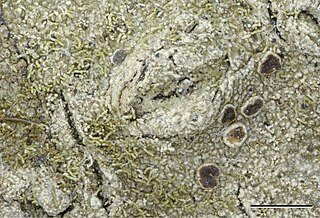
Neoprotoparmelia is a genus of crustose lichens that was created in 2018. It contains 24 tropical and subtropical species that mostly grow on bark. Neoprotoparmelia is in the subfamily Protoparmelioideae of the family Parmeliaceae, along with the morphologically similar genera Protoparmelia and Maronina.
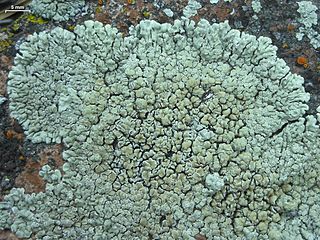
Protoparmeliopsis is a genus of saxicolous (rock-dwelling, crustose lichens in the family Lecanoraceae. It has about 20 species. The genus was circumscribed by French botanist Maurice Choisy in 1929.

Rhizocarpales are an order of lichen-forming fungi in the subclass Lecanoromycetidae of the class Lecanoromycetes. It has two families, Rhizocarpaceae and Sporastatiaceae, which contain mostly crustose lichens.
Allocetraria corrugata is a species of foliose lichen in the family Parmeliaceae. It is found in high-elevation locations in Yunnan, China, where it grows on rocks with mosses.
Neoprotoparmelia capitata is a species of corticolous (bark-dwelling) and crustose lichen in the family Parmeliaceae. It is found in eastern North America.











